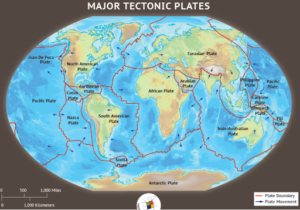In news– Researchers from the University of Adelaide, Australia, have carried out a new study that includes an updated map of the earth’s tectonic plates.
About new map-
- The study, titled ‘New maps of global geological provinces and tectonic plates’, delved into the past construction of continents like the first supercontinent, Vaalbara.
- Vaalbara fragmented to form other supercontinents over the years, the last being Pangea, which existed some 335-65 million years ago.
- Pangea again gave way to the seven modern continents which make the earth’s land surface today.
- A tectonic plate “is a massive, irregularly shaped slab of solid rock”, made up of lithosphere or the earth’s top layer. Tectonic plate movements often lead to earthquakes and volcanoes.
- The new map will help in forming a better understanding of natural hazards like earthquakes and volcanoes.
- The study explains the spatial distribution of 90 percent of earthquakes and 80 percent of volcanoes from the past two million years whereas existing models only capture 65 percent of earthquakes.

- According to the researchers, the continents were assembled a few pieces at a time, a bit like a jigsaw. But each time the puzzle was finished, it was cut up and reorganised to produce a new picture.
- The researchers combined three models to map the new geological provinces and tectonic plates:
- A plate model based on the existing knowledge of tectonic plates
- A province model based on the geological information of the earth’s surface
- An orogeny model based on the process of mountain formation which is triggered when two tectonic plates collide.
- As per this study, there are 26 orogenies — the process of mountain formation — that have left an imprint on the present-day architecture of the crust. Many of these, but not all, are related to the formation of supercontinents.
- The last time the tectonic plate model was updated was back in 2003.
- The new study added several new microplates to the existing tectonic plate model like the Macquarie microplate which sits south of Tasmania and the Capricorn microplate that separates the Indian and Australian plates.
- But according to the study, the biggest update to the existing plate model has been in western North America.
- The newly delineated boundary is much wider, approximately 1,500 km, than the previously drawn narrow zone.
- The other large change is in central Asia.
- The new model now includes all the deformation zones north of India as the plate bulldozes its way into.
- The researchers have said that the plate model can be used to evaluate risks from natural hazards; the province model can be used for further exploration of minerals and the orogeny model for a better understanding of the evolution of the earth.
Source: Down To Earth
















